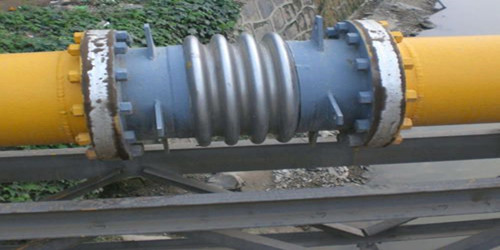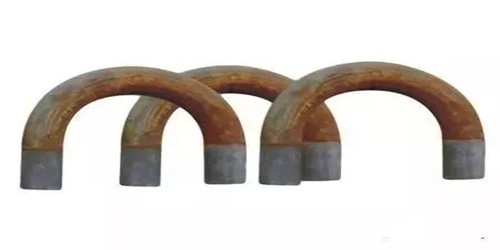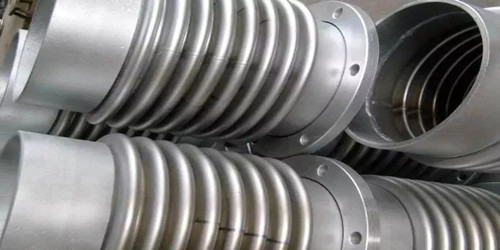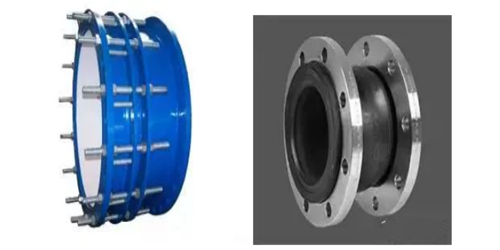Knowledge of steel pipe expansion joint
Knowledge of steel pipe expansion joint

Expansion joint
Expansion joint can also be called pipe expansion joint, expansion joint, compensator and expansion joint. The expansion joint is a new product connecting the pump, valve, pipeline and other equipment with the pipeline. They are connected by full bolts to make them become a whole, and have a certain displacement, which is convenient for installation. It can bear the axial pressure of pipeline. In this way, the installation and maintenance can be adjusted according to the size of the field installation. During the work, not only the work efficiency is improved, but also the pipeline equipment such as pumps and valves can be protected.
The connection form of the expansion joint is flange connection, one side flange, one side welding.

The function of expansion joint
1. Compensate the expansion deformation caused by axial, transverse and angular heating of absorption pipe.
2. Absorb equipment vibration and reduce the impact of equipment vibration on pipeline.
3. Absorb the deformation of pipeline caused by earthquake and ground subsidence.
Because of the thermal expansion and cold contraction of the pipeline, the stress and push force of the pipe wall will be generated; the stress of the pipe wall will affect the strength of the pipeline, and the push force will increase, so the fixed support of the pipeline will have to do a lot to bear the push force generated by the expansion and contraction of the pipeline; therefore, the variable opening method of expansion joint compensation is used to reduce the wall stress and thrust.
The expansion joint is classified according to the structure type
The expansion joint (expansion joint) is mainly used to compensate the expansion deformation caused by the temperature change of the pipeline, and also used for the length compensation required by the installation and adjustment of the pipeline. According to the structure, it is mainly divided into elbow type expansion joint, bellows expansion joint and sleeve expansion joint.
Elbow expansion joint
A kind of expansion joint that bends the pipe into U-shape or other forms (as shown in the figure below [elbow type expansion joint]) and compensates with the elastic deformation capacity of the body. It has the advantages of good strength, long service life and can be made on site. The disadvantages are that it takes up a lot of space, consumes more steel and has high friction resistance. This kind of expansion joint is widely used in various steam pipes and long pipes.

Bellows expansion joint
An expansion joint made of metal bellows. It can stretch and contract along the axis direction, but also allows a small amount of bending. The following figure [bellows expansion joint] is a common axial bellows expansion joint, which is used for axial length compensation on the pipeline. In order to prevent exceeding the allowable compensation amount, the two ends of the bellows are provided with protective pull rods or protection rings, and the guide supports are set on the pipes at both ends connected with the bellows. In addition, there are corner type and transverse type expansion joint, which can be used to compensate the angular deformation and transverse deformation of the pipeline. The advantages of such expansion joints are saving space, saving materials (official account: pipe circle), which is convenient for standardization and batch production, and the shortcoming is short life. Bellows expansion joint is generally used in the pipe with low temperature and pressure and short length. With the improvement of bellows production technology, the application scope of this kind of expansion joint is expanding. It is composed of bellows (an elastic element) and accessories such as end pipe, bracket, flange and conduit. It is mainly used in various pipelines. It can compensate the thermal displacement, mechanical deformation and absorb all kinds of mechanical vibration. It can reduce the deformation stress and improve the service life of the pipeline. The connection mode of corrugated compensator is divided into flange connection and welding. The directly buried pipeline compensator is usually welded.

Casing expansion joint
It is composed of inner and outer casings which can make relative axial movement (the following figure [casing expansion joint]). Stuffing box is used to seal the inner and outer casing. When using, keep the tubes at both ends moving on one axis. Guide supports are installed at both ends of the expansion joint. It has the advantages of small friction resistance to fluid flow and compact structure, and its disadvantage is poor sealing performance and large thrust on fixed support. Casing expansion joint is mainly used for water pipeline and low pressure steam pipeline.

The expansion joint is classified by material
According to the material, it is mainly divided into rubber pipe expansion joint and metal pipe expansion joint.
Characteristics of rubber pipe expansion joint
1、 Small size, light weight, good elasticity, easy installation and maintenance.
2、 Installation can produce axial, transverse, meridional, angular displacement, not by the user's pipe is not concentric, flange is not parallel restrictions.
3、 It can reduce vibration and noise when working.
4、 With special synthetic rubber, it can resist high temperature, acid, alkali and oil. It is an ideal product for chemical corrosion resistant pipeline.
Characteristics of metal pipe expansion joint
Large expansion compensation, high temperature and high pressure.
Non metallic expansion joint
Air duct rubber compensator
Air duct rubber compensator is composed of rubber and rubber fiber fabric composite material, steel flange, sleeve and thermal insulation material. It is mainly used for flexible connection between various fans and air ducts. Its functions are shock absorption, noise reduction, sealing, medium resistance, easy displacement and installation. It is an ideal matching set for vibration reduction, noise reduction, smoke and dust removal in the field of environmental protection.
Fiber fabric expansion joint
Fabric compensator is mainly made of fiber fabric, rubber, and other high temperature resistant materials. It can compensate the vibration of fan and duct and the deformation of pipeline. The fiber fabric expansion joint can compensate axial, transverse and angular products. It has the characteristics of no thrust, simplified support design, corrosion resistance, high temperature resistance, noise elimination and vibration reduction. It is especially suitable for hot air pipe and smoke pipe of power plant. The fiber fabric and thermal insulation cotton in the non-metallic Compensator have the function of sound absorption and vibration isolation, which can effectively reduce the noise and vibration of boiler, fan and other systems. It has simple structure, light weight and convenient maintenance.
Characteristics and application scope of various pipe expansion joints
Non metallic expansion joint
Non metallic flexible compensator: also known as non-metallic expansion joint and non-metallic fabric compensator, it can compensate axial, transverse and angular directions. It has the characteristics of no thrust, simplified support design, corrosion resistance, high temperature resistance, noise elimination and vibration reduction, and is especially suitable for hot air pipeline and dust pipe.
Characteristic:
1. Compensation for thermal expansion: it can compensate multi direction, which is much better than metal compensator which can only compensate in single way.
2. Compensation for installation error: due to the inevitable system error in the process of pipeline connection, the fiber compensator can better compensate the installation error.
3. Noise elimination and vibration reduction: fiber fabric and thermal insulation cotton have the function of sound absorption and vibration isolation transmission, which can effectively reduce the noise and vibration of boiler, fan and other systems.
4. No reverse thrust: because the main material is fiber fabric, the transmission is weak. The use of fiber compensator can simplify the design, avoid the use of large bearings, and save a lot of materials and labor.
5. Good high temperature resistance and corrosion resistance: fluoroplastics and silicone materials have good high temperature resistance and corrosion resistance.
6. Good sealing performance: with perfect production and assembly system, fiber compensator can ensure no leakage.
7. Light weight, simple structure, convenient installation and maintenance.
8. The price is lower than the metal compensator and the quality is better than the imported products.
Stainless steel: there are four types of stainless steel: straight cylinder type, compound type, angular type and square type.
The stainless steel compensator can compensate axial, transverse and angular direction, has the characteristics of no thrust, simplified support design, corrosion resistance, high temperature resistance, noise elimination and vibration reduction, and is especially suitable for hot air pipe and smoke pipe.
Metal: the reliability of metal corrugated compensator is composed of design, manufacture, installation and operation management. Reliability should also be considered from these aspects. In addition to the working medium, working temperature and external environment, the possibility of stress corrosion, the influence of water treatment agent and pipeline cleaning agent on the material should be considered in the material selection of corrugated pipe used for heat supply network. On this basis, the economical and practical bellows material is optimized by combining the welding, forming and performance price ratio of the material.
Generally, the material of bellows shall meet the following conditions:
(1) High elastic limit, tensile strength and fatigue strength ensure normal operation of bellows.
(2) Good plasticity, easy to process and form bellows, and can obtain enough hardness and strength through subsequent treatment process (cold work hardening, heat treatment, etc.).
(3) Good corrosion resistance, meet the requirements of bellows in different environments.
(4) Good welding performance, meet the welding process requirements of bellows in the production process.
For the heat pipe network laid in the trench, when the pipeline where the compensator is located is at a low terrain, the corrugated pipe will be soaked by rainwater or accidental sewage. Therefore, materials with stronger corrosion resistance, such as iron nickel alloy and high nickel alloy, should be selected. Due to the high price of this kind of material, only a layer of corrosion-resistant alloy can be added to the surface contacting with corrosive medium when manufacturing bellows. The fatigue life design shows that the plane stability, circumferential stability and corrosion resistance of bellows are related to the displacement, i.e. fatigue life. Too low fatigue life will lead to the decline of stability and corrosion resistance of metal bellows.




